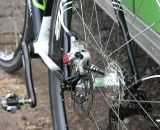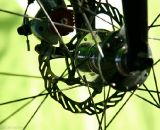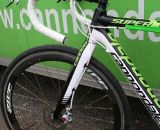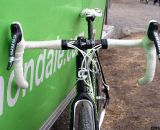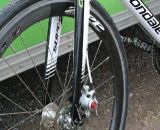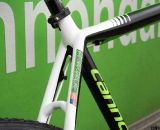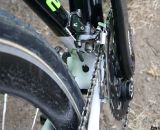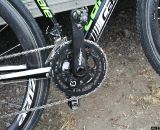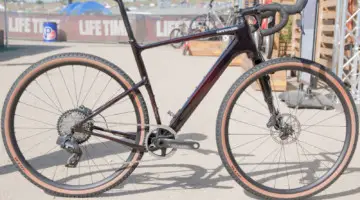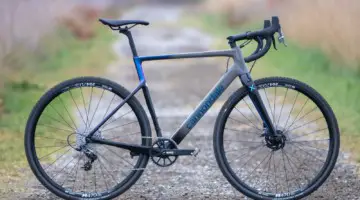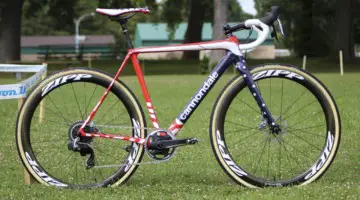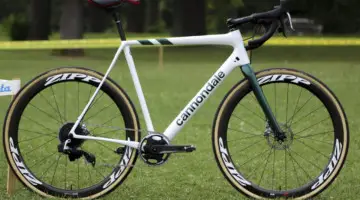Tim Johnson, one of America’s top ’crossers, has had a disc-brake-equipped prototype carbon Cannondale SuperX on board the Cannondale-Cyclocrossworld.com team truck for most of the season, but he’s only busted it out in races recently. It was aboard that rig that Johnson finally notched his first wins of the season, at the third day of Jingle Cross and the first day of the Cyclocross LA UCI event. In the process, he became the first rider to win a UCI race on a disc-brake cyclocross bike. [Read more from Tim about his first win and his new bike in our exclusive interview.]
Johnson almost one-upped those performances in the first day of the USGP weekend in Bend, where he finished just behind former teammate Jeremy Powers (Rapha-Focus) in a mad sprint for the line. It was in Bend that we sweet-talked team manager Stu Thorne into letting us spend some alone time with the bike to snap some photos, and we asked Thorne about the performance of the bike and what we might expect in the world of disc brake ’cross bikes soon.
Johnson’s Jingle Cross win was in muddy conditions, an area where one would expect disc brakes to shine, but both the California and Oregon races were dry. And it was in L.A. that Thorne says the brakes really showed their benefit. “Tim was in a duel with Ben Berden [Ops Ale-Stoemper] that first day in L.A.,” says Thorne. “Ben came up to us afterwards and said that Tim was just slightly gapping him through every corner, just because of the better modulation and the ability to brake a little later. Ben then got on the bike and rode it around a bit, he was pretty blown away by disc brakes.”Weight is one thing that naysayers typically hold against a disc-brake configuration but, according to Thorne, Johnson’s disc brakes only adds about a half-pound. And that’s with some inefficiencies. “These are regular rims, built up for rim brakes – they could be lightened up if they were made specifically for discs,” says Thorne. “The hubs on here right now are pretty heavy too, they could be lightened up. And there’s some extra hardware for routing traditional brake cables and things like that; we could strip that stuff off.”
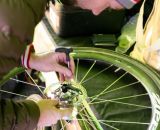
Cannondale-Cyclocrossworld.com Matt Roy tightens the disc rotors on Johnson's Zipp 303s © Whit Bazemore
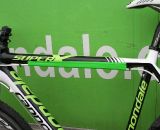
It may be a prototype, but even the electrical tape quick cable routing fix is in Cannondale bright green. ©Cyclocross Magazine
Thorne informed us that because of the logistics of bringing multiple bikes and extra wheels across, and since Johnson already has rim-brake bikes in Europe, they won’t be taking the disc brake bikes over for this current racing swing, but we’ll be looking for them at Nationals. Earlier in the year, multi-time Danish national champ Joachim Parbo told CXM that if he could get his equipment together that he’d be an early adopter and perhaps the first to race a disc brake bike in a World Cup.
Super X Disc Bike Prototype
Frame/Fork: Cannondale carbon Super X Disc prototype
Wheels: Zipp 303s with White Industries disc hubs
Tires: Dugast Rhinos and Dugast Typhoons
Drivetrain: SRAM Red with Quarq crank set
Brakes: Avid BB7’s
Pedals Older model Shimano XTR
Cockpit and Seat post: Zipp
Weight: According to Thorne, about 16.5 pounds (with rim brakes, they’re right at the UCI limit, just under 16lbs.)
Photo Gallery:














